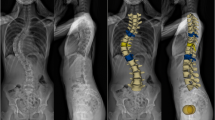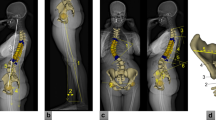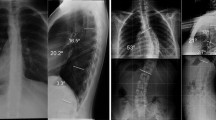Abstract
Purpose
Marfan syndrome (MFS) is a genetic disease often marked by the presence of scoliosis. There is no three-dimensional analysis of the deformity in the literature. Our aim was to determine what kind of sagittal balance defines scoliosis associated with MFS, namely a flexion deformity, as it is in scoliosis associated with Chiari I or an extension deformity, as in adolescent idiopathic scoliosis (AIS). To address this issue, we compared the presence or absence of a thoracic scoliosis with the presence or absence of a segment in extension in the thoracic spine.
Methods
In our series, 30 patients diagnosed with Marfan syndrome were prospectively included. In each patient, personalized three-dimensional reconstruction from T1 to L5 of the spine was made using stereoradiography. The patients were first separated based on the presence or absence of thoracic scoliosis, in order to compare this with the presence or absence of a segment in extension in the thoracic spine. They were then classified into two groups based on the presence or absence of the segment in extension (meaning containing negative values of inter-vertebral sagittal rotation) in the thoracic spine.
Results
Among scoliotic patients with a thoracic scoliosis (17 cases), there were 13 (76.5% cases) with a segment in extension in the thoracic spine and 4 with no segment in extension.
Conclusions
Our results showed that scoliosis associated with MFS is somehow original, demonstrating a sagittal balance in extension (as AIS) in about 80% of thoracic curves, but without this characteristic feature in about 20%.



Similar content being viewed by others
References
Pyeritz RE (1993) The Marfan syndrome. In: Royce PM, Steinmann B (eds) Connective tissue and its heritable disorders: molecular, genetic, and medical aspects. Wiley-Liss, New York, pp 437–468
Sponseller PD, Hobbs W, Riley LH 3rd, Pyeritz RE (1995) The thoracolumbar spine in Marfan syndrome. J Bone Joint Surg Am 77:867–876
Birch JG, Herring JA (1987) Spinal deformity in Marfan syndrome. J Pediatr Orthop 7:546–552
Robins PR, Moe JH, Winter RB (1975) Scoliosis in Marfan’s syndrome. Its characteristics and results of treatment in thirty-five patients. J Bone Joint Surg Am 57:358–368
Jones KB, Erkula G, Sponseller PD, Dormans JP (2002) Spine deformity correction in Marfan syndrome. Spine 27:2003–2012
Di Silvestre M, Greggi T, Giacomini S et al (2005) Surgical treatment for scoliosis in Marfan syndrome. Spine 30:E597–E604
Lipton GE, Guille JT, Kumar SJ (2002) Surgical treatment of scoliosis in Marfan syndrome: guidelines for a successful outcome. J Pediatr Orthop 22:302–307
Pomero V, Mitton D, Laporte S, de Guise JA, Skalli W (2004) Fast accurate stereoradiographic 3D-reconstruction of the spine using a combined geometric and statistic model. Clin Biomech (Bristol, Avon) 19:240–247
Perdriolle R, Vidal J (1981) A study of scoliotic curve. The importance of extension and vertebral rotation (author’s transl). Rev Chir Orthop Reparatrice Appar Mot 67:25–34
Ouellet JA, LaPlaza J, Erickson MA et al (2003) Sagittal plane deformity in the thoracic spine: a clue to the presence of syringomyelia as a cause of scoliosis. Spine 28:2147–2151
Loder RT, Stasikelis P, Farley FA (2002) Sagittal profiles of the spine in scoliosis associated with an Arnold-Chiari malformation with or without syringomyelia. J Pediatr Orthop 22:483–491
De Paepe A, Devereux RB, Dietz HC, Hennekam RC, Pyeritz RE (1996) Revised diagnostic criteria for the Marfan syndrome. Am J Med Genet 62:417–426
Stokes IA (1994) Three-dimensional terminology of spinal deformity. A report presented to the Scoliosis Research Society by the Scoliosis Research Society Working Group on 3D terminology of spinal deformity. Spine 19:236–248
Giraudeau B, Mary JY (2001) Planning a reproducibility study: how many subjects and how many replicates per subject for an expected width of the 95% confidence interval of the intraclass correlation coefficient. Stat Med 20:3205–3214
Beighton P, De Paepe A, Hall JG et al (1992) Molecular nosology of heritable disorders of connective tissue. Am J Med Genet 42:431–448
Dietz HC, Cutting GR, Pyeritz RE et al (1991) Marfan syndrome caused by a recurrent de novo missense mutation in the fibrillin gene. Nature 352:337–339
Graf H, Hecquet J, Dubousset J (1983) 3-dimensional approach to spinal deformities. Application to the study of the prognosis of pediatric scoliosis. Rev Chir Orthop Reparatrice Appar Mot 69:407–416
Cruickshank JL, Koike M, Dickson RA (1989) Curve patterns in idiopathic scoliosis. A clinical and radiographic study. J Bone Joint Surg Br 71:259–263
Deacon P, Archer IA, Dickson RA (1987) The anatomy of spinal deformity: a biomechanical analysis. Orthopedics 10:897–903
Guo X, Chau WW, Chan YL, Cheng JC (2003) Relative anterior spinal overgrowth in adolescent idiopathic scoliosis. Results of disproportionate endochondral-membranous bone growth. J Bone Joint Surg Br 85:1026–1031
Dubousset J, Herring JA, Shufflebarger H (1989) The crankshaft phenomenon. J Pediatr Orthop 9:541–550
Gigante A, Chillemi C, Greco F (1999) Changes of elastic fibers in musculoskeletal tissues of Marfan syndrome: a possible mechanism of joint laxity and skeletal overgrowth. J Pediatr Orthop 19:283–288
Spiegel DA, Flynn JM, Stasikelis PJ et al (2003) Scoliotic curve patterns in patients with Chiari I malformation and/or syringomyelia. Spine 28:2139–2146
Flynn JM, Sodha S, Lou JE et al (2004) Predictors of progression of scoliosis after decompression of an Arnold Chiari I malformation. Spine 29:286–292
King HA, Moe JH, Bradford DS, Winter RB (1983) The selection of fusion levels in thoracic idiopathic scoliosis. J Bone Joint Surg Am 65:1302–1313
King HA (1988) Selection of fusion levels for posterior instrumentation and fusion in idiopathic scoliosis. Orthop Clin North Am 19:247–255
Dansereau J, Stokes IA (1988) Measurements of the three-dimensional shape of the rib cage. J Biomech 21:893–901
Mitton D, Landry C, Veron S et al (2000) 3D reconstruction method from biplanar radiography using non-stereo corresponding points and elastic deformable meshes. Med Biol Eng Comput 38:133–139
Gille O, Champain N, Benchikh-El-Fegoun A, Vital JM, Skalli W (2007) Reliability of 3D reconstruction of the spine of mild scoliotic patients. Spine 32:568–573
Perdriolle R, Vidal J (1987) Morphology of scoliosis: three-dimensional evolution. Orthopedics 10:909–915
Perdriolle R, Le Borgne P, Dansereau J, de Guise J, Labelle H (2001) Idiopathic scoliosis in three dimensions: a succession of two-dimensional deformities? Spine 26:2719–2726
Dickson RA, Lawton JO, Archer IA, Butt WP (1984) The pathogenesis of idiopathic scoliosis. Biplanar spinal asymmetry. J Bone Joint Surg Br 66:8–15
Author information
Authors and Affiliations
Corresponding author
About this article
Cite this article
Glard, Y., Pomero, V., Collignon, P. et al. Sagittal balance in scoliosis associated with Marfan syndrome: a stereoradiographic three-dimensional analysis. J Child Orthop 2, 113–118 (2008). https://doi.org/10.1007/s11832-008-0083-3
Received:
Accepted:
Published:
Issue Date:
DOI: https://doi.org/10.1007/s11832-008-0083-3




